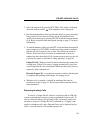
LTR-NET AUXILIARY CALLS
33
3. Select the dial mode by pressing FCN DIAL. This mode is indicated
when the handset portion of the telephone icon is displayed.
4. Dial the desired number which specifies the mobile or group of mobiles
being called. If it has been previously stored, this number can be
recalled from memory by pressing FCN RCL and the location number
(0-9). Refer to the dial mode description starting on page 37 for more
information.
5. To send the number, briefly press the PTT switch and then when the dial
tones sounds, press FCN SND. Another tone then sounds to indicate
that the call was accepted by the system. The call then proceeds as
follows. If this tone does not sound, an unauthorized or incorrect
number may have been dialed. If all system resources are busy, the call
is placed in a queue as described in “Busy Queuing” on page 46.
Unique ID Call - Ringing is heard to indicate that the other transceiver
is being rung. If there is no answer, ringing automatically stops after
several rings and the call is terminated. When the other party answers,
respond as with a standard call.
Directed Group Call - A second tone sounds to indicate that the path
is complete and speaking should begin. No ringing occurs.
6. When the call is complete, it should be terminated the same as
described in step 6 on page 31. Three beeps indicate that the call has
been terminated.
Receiving Auxiliary Calls
To receive a Unique ID call, all that is required is that an LTR-Net
system is selected that contains a group programmed for those calls. To
receive a Directed Group call, the group of the call usually needs to be
selected or scanned. A Unique ID call is indicated by a “ringing” tone
similar to telephone calls, and a Directed Group call is indicated by the
caller’s voice the same as with standard group calls.


















